L.A. has a date with The Rock
May 21, 2012
Southern California’s favorite 340-ton megalith will be unveiled to the public on June 24 at a dedication ceremony for “Levitated Mass,” the Michael Heizer art installation in which the now-famous boulder dubbed “The Rock” will perch atop a massive, walk-through slot on the campus of the Los Angeles County Museum of Art.
At the top of the invitation list to see this new heavyweight attraction on the international art scene are the folks whose communities the boulder passed through on its slow-mo journey from a Riverside County quarry to LACMA. All residents who live in the 61 ZIP codes traversed by The Rock are being offered free admission to the museum and its grounds during the week of June 24 through July 1. Proof of residency, such as a driver’s license, will be required. Click here to see if your ZIP code’s on the list.
It’s intended as a thank you to the communities—from Jurupa Valley to Rowland Heights to Long Beach to Los Angeles—that played a part in The Rock’s epic voyage. The trip turned into a festive happening all along the route, with thousands turning out to marvel and, perhaps, plan their first-ever visit to LACMA to behold the boulder once it’s on permanent display. Our video showcases The Rock’s voyage into Southern California history.
As The Rock meets its public for the first time in its new home next month, the museum will also open an exhibition called “Michael Heizer: Actual Size,” a collection of large-scale photographs and projections of other works by the reclusive Nevada artist who created the installation. Heizer lived for a time on the LACMA grounds while “Levitated Mass” was being assembled.
“We live in a world that’s technological and primordial simultaneously,” Heizer said in a statement released by LACMA as part of its announcement. “I guess the idea is to make art that reflects this premise.”
Posted 5/21/12
Beverly Hills urges more subway study
May 18, 2012
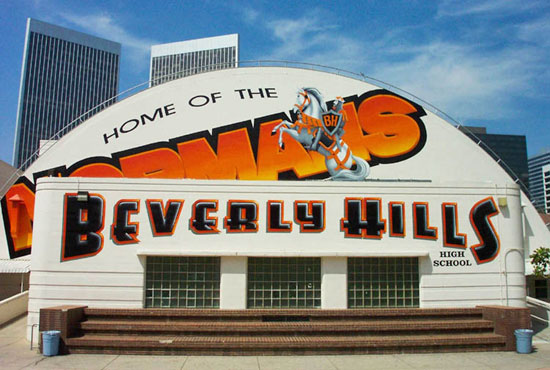
Experts for Beverly Hills say Metro doesn't need to tunnel under the high school to get to Century City.
Scientific experts and lawyers representing the city of Beverly Hills and its school district told the Metro board on Thursday that the agency’s research into placement of a Century City subway station is flawed and inadequate, and urged the board to delay making a final decision until extensive new testing can be performed.
“We implore you to take the time—because you have the time—to make the right choice,” Beverly Hills City Attorney Larry Wiener said toward the end of a special hearing the city had requested under a rarely-used provision of the state Public Utilities Code.
The city has objected to plans to tunnel under Beverly Hills High School in order to build a Century City station at Constellation Boulevard as part of the Westside Subway project, saying it is potentially unsafe for students and would interfere with future campus development.
Metro’s own experts—including noted earthquake authority Lucy Jones, part of an independent review panel that assessed the agency’s findings—say the Constellation location would be safe. They say that an alternate location on Santa Monica Boulevard—which would avoid tunneling under the high school—is unsuitable for a station because of active earthquake faults there.
Beverly Hills’ experts disagreed on a number of key points.
They said there is evidence that earthquake faults along Santa Monica Boulevard are inactive and thus pose no threat. They also contend that Metro has not performed adequate scientific testing and risk analysis to determine whether the Constellation location is safe.
Beverly Hills commissioned its own trenching studies on the high school campus and its experts have produced a series of reports intended to challenge Metro’s findings on the route the subway should take to get to Century City. (The Beverly Hills reports are here; Metro’s responses to the reports are here, along with other scientific and environmental documents.)
On Thursday, Beverly Hills experts testified that their trenching method was more extensive and produced more accurate results than Metro’s method of boring into the earth and taking samples at the high school site. The Beverly Hills experts said they found no earthquake faults on the campus. And they said they found it curious that Metro’s experts, who had determined that there are faults on the campus, changed the mapped location of those faults after reviewing the Beverly Hills findings.
One of the consultants testifying for Beverly Hills, Tim Buresh, said that Metro’s tunneling plans could interfere with future underground development on the high school campus—which prompted some skeptical questions from Supervisor Zev Yaroslavsky, a member of Metro’s board of directors.
“There is no way in the world that the school district is going to build a six-story building underground, is there, Mr. Buresh?” Yaroslavsky asked.
Buresh insisted it was “entirely possible” that the school might eventually do so.
Buresh, a former executive with the California High-Speed Rail Authority, also drew skeptical questions from another Metro director, Richard Katz.
After Buresh told the Metro board that “you don’t gamble with children’s safety, ever—period,” Katz asked him why he had once advocated running a high speed train under another school, Miramar College in San Diego, saying it would have only “insignificant impacts.”
Buresh replied that he left the rail agency before he had a chance to change his position on that, but said he would have ultimately advocated another route that avoided the college.
Other than a handful of questions from the Metro board, the hearing was devoted entirely to speakers representing Beverly Hills.
The Metro board has approved the Westside Subway’s final environmental documents, but has deferred a decision on placement of the Century City station until after the Beverly Hills hearing could be held. The earliest the board could take up the matter would be at its regularly scheduled monthly meeting on May 24.
Toward the end of Thursday’s 3½-hour-long hearing, an attorney representing Beverly Hills, Robert McMurry, presented the Metro board with three alternate routes that he said would make it possible to build a station at Constellation without going under the high school. He urged the Metro board to hold off on any decision about the siting of a Century City station until it can gather more information.
“Now is not the time to make that decision. Otherwise, you’re going to shortchange us, you’re going to subject Metro to greater delays due to litigation and even worse consequences if you lose the litigation,” McMurry said.
Yaroslavsky said the Metro board will consider the experts’ opinions on both sides of the issue before making a final decision.
“All in all, I thought the city and school district of Beverly Hills made a professional presentation. Not surprisingly, their experts’ conclusions are diametrically opposite of Metro’s, so we will have to review the testimony and reconcile the differences before making a final decision on the subway alignment,” Yaroslavsky said. “This is a problem that can be solved, but the hysteria that has characterized some of the debate needs to be dropped. Today was a good start.”
Posted 5/17/12
Calling all condom designers
May 17, 2012
There are a million free condoms in the naked city, and the Los Angeles County Department of Public Health sees a branding opportunity in that.
In an effort to help curb sexually transmitted diseases, the department’s Division of HIV and STD Programs this month will announce a contest to design an official L.A. condom wrapper to help brand the free prophylactics the county distributes to local businesses, social services and healthcare providers. Ads will invite county residents to come up with “L.A.’s Next Sex Symbol.”
“Our tagline is going to be ‘Show Me Your Package’,” says Project Manager True Ann Beck.
The lighthearted derby is part of a serious push in Los Angeles County to consolidate public health outreach on sexually transmitted diseases. An estimated 2,000 new HIV infections occur annually in L.A. County. Last year, the department reported more than 47,500 new cases of chlamydia, more than 9,500 new cases of gonorrhea and nearly 1,800 new cases of syphilis.
Each year, grant money is distributed by the county to local health care providers to purchase and distribute free condoms, which help prevent sexually transmitted diseases. (About 250,000 have been handed out so far this year, at a wholesale price of about six cents apiece, Beck says.) The contest is a small part of a larger centralization of STD prevention that has already merged three county programs.
The design contest, which will run from May 21 to June 17, will be facilitated by KCBS Marketing with help from the county’s condom wholesaler, Boston-based One Condoms, Beck says. Entrants must be Los Angeles County residents over the age of 18.
Rules will be posted on the contest web site (LASexSymbol.com), but generally, entries cannot be trademarked, copyrighted or sexually explicit. The winner and nine runners-up will receive prizes and gift cards, plus bragging rights to a package design that will be distributed countywide and featured in future condom promotions. All ten will be produced and distributed.
“We want to circulate more than one design so people can collect them all,” Beck says, adding that the initial plan is “to start with a million and one condoms.”
Updated 6/14/12: Learn more about the contest at the Downtown L.A. Art Walk tonight. Check out the 40-foot RV parked at 24 Main Street.
Public health officials note that contests are only one way among many to raise awareness and improve Southern California’s health. Still, New York’s 2010 contest attracted nearly 600 entries, persuaded New Yorkers to cast more than 15,000 online ballots and conferred momentary celebrity on the graphic artist who submitted the winning wrapper design—a graphic representation of a high-tech power button.
Beck says the hope is that the entries will be so smart and lively that the public won’t think of the free condoms as a government program.
“It’s going to be very light and sexy and fun. We’ll probably get all sorts of comments, but the point is to get people talking, and to get them to practice safer sex,” she says.
Posted 5/17/12
Focus on ramps at community meeting
May 17, 2012
Things are gearing up as the 405 Project moves closer to completion in 2013. Major work is beginning on the Wilshire Boulevard ramps to and from the 405, and construction also is starting on the Sepulveda Boulevard overpass in Sherman Oaks. For specific questions or a general update, residents can attend Metro’s community meeting on Thursday, May 24.
The meeting will take place from 6 p.m. to 8 p.m. in Room C of the Westwood Recreation Center, 1350 South Sepulveda Boulevard. Future community meetings will be held on July 26, September 27 and November 15, at locations yet to be determined.
Posted 5/17/12
Here comes L.A.’s big sports weekend
May 17, 2012
You may have heard that this weekend will be “Sportsageddon”—the latest end-of-times-themed Los Angeles traffic snarl, spawned this time by a confluence of marquee sporting events. While much of the focus has been on downtown near Staples Center, motorists in other parts of the city should prepare for another obstacle on Sunday, May 20—the final stage of the 44-mile Amgen Tour of California professional bike race.
The race stage begins on Rodeo Drive in Beverly Hills at 9:30 a.m., and will travel east through the city before finishing at L.A. Live at about noon—just in time for the L.A. Kings playoff game at the Staples Center, to be followed later by the Clippers game. (Oh, and there’s a Dodgers game at the stadium on Sunday, too.)
Rolling street closures will accompany the bikes along the way—including the closure of Hollywood Boulevard.
This detailed map shows the route and times of expected closures, and you can also keep up with closures and traffic conditions in “real time” with the Los Angeles Department of Transportation’s traffic information site.
Meanwhile, amateur cycling enthusiasts who want to plunge into the spirit of the race will be allowed to ride open streets downtown before the pros arrive, from 8 a.m. to 9:30 a.m. Sunday. The downtown circuit falls into Segment 6 of the race, with closures on parts of Hill Street, Olive Street, Olympic Boulevard, Pico Boulevard and 11th Street in the area between Pico and Temple. If you’d like to pedal the five-mile circuit, there is still time to sign up and join in.
Those who want to be part of the fun, but don’t want to brave the traffic, should plan their trip with Metro. The agency’s blog, The Source, has specific advice on how to use transit to avoid the closures.
Posted 5/17/12
Voter registration’s a click away
May 16, 2012
You go online to post your vacation photos, buy birthday gifts and share your relationship status.
But if you want to use the Internet to register to exercise one of the most fundamental rights of American citizenship—casting a vote—you’ve been out of luck.
Until now.
The county is embarking on a project with the California Secretary of State to make online voter registration a reality here before the November presidential election.
The $270,873 county program, paid for by federal funds passed along by the state, is part of the California Online Voter Registration Project that seeks to make registration easier for the 9 million Californians—39% of the eligible population—who aren’t currently signed up to vote.
While it won’t change the requirement mandating registration 15 days before an election, it will make it easier for those who push it right up to the wire—like the thousands of county residents who tried, and failed, to register to vote in time for the last presidential election.
Updated 10/11/12: County election officials say voter registrations hit a one-month high in September, with 150,000 signing up, compared to 120,000 in the previous record month, September, 2008. The increase is due, at least in part, to the ease of online registration, according to the Registrar-Recorder/County Clerk. The registration deadline for the Nov. 6 election is Oct. 22. Click here to register.
“In 2008, we received literally several thousand registration forms the day after the registration cutoff,” said Registrar-Recorder/County Clerk Dean Logan. “These were people who, at the point that they were engaged and interested in becoming active voters, the system in essence failed them, through an administrative deadline. It’s hard to measure the loss of that. You wonder, will they come back if they didn’t get to vote in the one election where they were interested?”
The system will allow would-be voters to sign their registration forms electronically using e-signatures on file with the DMV. A widget on the county’s voting website, www.lavote.net, will send them to the Secretary of State’s site to register online beginning in late August or early September, Logan said.
The move to electronic registration is part of a broader movement to modernize the nation’s voting systems and remove barriers to electoral participation. Only 10 states, including Washington, Oregon and Arizona, currently have online registration. California is in the process of becoming the 11th, under Senate Bill 397 passed last year. Los Angeles, Orange and Trinity are the three counties that will be pioneering the process for their respective voting systems, before the whole state follows suit.
In a letter to the Board of Supervisors, which this week approved the county’s participation in the program, Logan and county Chief Information Officer Richard Sanchez said that younger voters between the ages of 18 and 25 are most likely to take advantage of the online registration option.
But Logan said it will also make it easier for anyone who moves within the state to keep their voter registration up to date.
Posted 4/17/12
Assessor hit for faulty forecasts
May 16, 2012
 When it comes to forecasting the rise and fall of home prices, the Los Angeles County Assessor’s Office needs to get its house in order.
When it comes to forecasting the rise and fall of home prices, the Los Angeles County Assessor’s Office needs to get its house in order.
That was the conclusion of a team of consultants hired by the county to investigate how the assessor came to produce two widely different predictions of money that would be generated by this year’s property taxes. In one fell swoop, the amount of growth forecast for property values plunged from $18.6 billion in December to $5.1 billion in April—an unwelcome surprise for financially-strapped local government entities, including the county, that rely on the funds.
An irate Board of Supervisors last month called the disparity shocking and unprecedented, and ordered a top-to-bottom audit of the office run by Assessor John Noguez, who already was under fire for allegedly giving special treatment to certain property owners, an accusation he has denied.
On Tuesday, the first phase of that audit was presented to the supervisors, and it did not paint a flattering portrait of assessor operations.
Consultants from the firm Rosenow Spevack Group found numerous flaws in how the two forecasts were reached—from failing to account for home price volatility at the close of last year to making errors in math. RSG, which was retained by the county’s auditor-controller, concluded that the December forecast of 1.77 percent revenue growth was too high and that the April forecast of .49 percent growth was too low.
Based on more complete information, RSG and the Assessor’s Office now agree that rate of growth in property tax revenue will be closer to 1.14%.
The most significant forecasting error, according to RSG, was the assessor’s failure to recognize, and account for, an unexpected decline in value for hundreds of thousands of parcels in the final quarter of last year. The assessor’s office had based its December forecast on information generated between January and September 2011, when prices were relatively stable, without examining available sales data or economic analyses for the latter part of the year. The result: an overly optimistic forecast, Jim Simon of RSG told the board.
Mistakes were also made in the April forecast, he said, including an overstatement of the estimated drop in the property tax roll because of “a calculation error.”
In a letter accompanying RSG’s report, Auditor-Controller Wendy Watanabe noted that, during the past several years, the assessor’s office has been hit with numerous retirements in key management roles, “which has resulted in significant turnover in the staff who prepare the roll forecasts.” Watanabe’s office is now examining the management of the assessor’s office, including whether it has been hurt by the controversies surrounding Noguez, who, along with other members of his staff, are under investigation by the District Attorney’s public integrity unit.
That a controversy over forecasts could even flare seems unique to Los Angeles government.
According to RSG, it appears that no other assessor in the state is producing multiple forecasts like Los Angeles. For 20 years, the L.A. County assessor has been producing three of them as a way to help the county’s Chief Executive Office prepare the county’s preliminary budget. Under state law, an assessor is only required to produce an annual forecast in May, if asked to do so by a governing body of a taxing agency.
“Their primary function is to be assessors” evaluating properties, Simon said, “not forecasters.”
Still, with the likelihood that multiple forecasts in Los Angeles County will continue, Simon’s team suggested a number of ways for the assessor to increase accuracy. They include: using the most current data available; evaluating properties on a more geographic-specific level, obtaining input from economists and other experts, and providing a range of values in forecasts, instead of settling on a specific number.
Posted 5/16/12
Riding to the rescue for 100 years
May 16, 2012

Bathing beauties were still posing on county lifeguard trucks in 1959. Photo/LA County Lifeguard Assn.
Summer isn’t summer in Los Angeles County without the bright yellow vehicles of the beach patrol.
“Iconic” is how Chief Lifeguard Mike Frazer described them last week as the Board of Supervisors gave the Department of Beaches and Harbors authority to sign a proposed agreement to take ownership of the fleet’s latest additions—45 custom-built Ford Escape hybrids that the county has leased since 2008. Under that proposed agreement, Ford Motor Co. would continue to advertise itself as the “Official Vehicle Sponsor” of the L.A. County beach lifeguards. So far, however, Ford has not agreed to a transfer of ownership.
Outfitted with state-of-the-art rescue equipment, the vehicles have saved not only lives but also more than $267,000 a year in fuel costs. “We’ve come a long way,” Chief Frazer says.
In fact, as the photo gallery below shows, beach rescue vehicles have come farther than Southern Californians might imagine. And to look back at their history is to dip into the region’s evolving—and sometimes dangerous—relationship with the beach.
Arthur Verge, an El Camino College history professor and veteran county lifeguard, notes that there was a time, not so long ago, when Southern Californians regarded the ocean as a frightening place that was best admired from afar. “Drownings were sadly common,” Verge says, adding that those who did go into the water often had no idea how to swim or how to get out of the powerful rip-currents that swept them out to sea in their heavy wool bathing outfits.
Professional ocean lifeguards didn’t even exist here until the early 1900s, when the City of Long Beach and real estate developers Abbot Kinney and Henry Huntington began paying “lifesavers” to reassure tourists outside the Long Beach Plunge and to promote the then-new developments of Venice and Redondo Beach.
Notably, Kinney and Huntington turned in 1907 to George Freeth, a celebrated Hawaiian surfer who not only trained L.A. County’s first generation of lifeguards but also pioneered rescue response.
“While fire departments were using horse-drawn rigs,” Verge says, “George Freeth, as early as 1912, was patrolling the beaches of Redondo, Hermosa and Manhattan Beach with a motorcycle, carrying a metallic rescue can in a special sidecar.”
Other early lifeguards were more low-tech.
“Santa Monica’s first lifeguard, ‘Cap’ Watkins, patrolled the beach on horseback,” Verge notes. “And George Wolf, the first Los Angeles city lifeguard, rode back on forth from Venice to El Segundo on a bike.”
By the late 1920s, both the city and county had lifeguards and trucks that ferried their gear along the boardwalks. That gear was stretched thin in the 1930s as the county lifeguards took over the beaches in the economically struggling South Bay.
“We didn’t get any new vehicles until the late ‘40s because World War II was on,” recalls Cal Porter, an 88-year-old retired county lifeguard and Malibu surfer. “If somebody had a bad rescue…we’d jump into this old 1933 International we had and head down Pacific Coast Highway. We’d be going as fast as we could, lights and sirens going—but all the other cars would be passing us.”
With wartime came the 4-wheel-drive jeep, developed by Willys-Overland Motors for the U.S. Army. The Willys allowed lifeguards for the first time to skip the boardwalk and drive directly across the sand. The jeeps were redeployed onto county beaches in the late 1940s; some remained in use for the next twenty years.
By the 1960s, the county had a fleet of Ford trucks with special racks for lifesaving equipment. Beaches filled with Baby Boomers and, occasionally, the products of the era’s experimental mood: In 1970, the county bought two customized dune buggies from the designer Meyers Manx. “But they didn’t work,” Verge says. “Sand would get into the carburetor.”
Lifeguard operations consolidated in the mid-1970s under the county, which by 1975 had the world’s largest lifeguard organization—a distinction that brought marketing opportunities. Among them was the chance for car companies to become the “official” rescue vehicle supplier to the now renowned L.A. County beach lifeguards.
Kerry Silverstrom, chief deputy director of the county Department of Beaches and Harbors, says that in 1986, Nissan and the beach lifeguards signed an agreement. “They got name recognition, ad copy and the ability to say they’re the official vehicle of the County beaches,” she notes, “and we got to use their vehicles for free.”
Nissan’s deal—releasing 30 chrome yellow 4×4 King Cab lifeguard trucks and six light pewter Stanza wagons onto the county beaches—lasted until 1994, when Ford won the contract. Nissan got it back in 1999, but Ford made another comeback with the hybrid SUVs in 2008.
Frazer says lifeguards were accustomed to pickup trucks with gas engines, and concerned that sand might damage hybrids. “But one of our missions is to protect the environment, so we said, ‘Let’s see if this works.’ ”
He says the results have been striking.
“The visibility is amazing and the turning radius is almost twice what we had, so we can navigate crowds better,” he says. “It has traction even in places like Point Dume, which has a steep sloping beach. “
Silverstrom says the relationship with Ford has been a financial and environmental lifesaver as the economy and the Internet have made branding rights a tougher sell at beaches. As for the next generation of vehicles, Frazer says the lifeguards “continue to look at all the options.” After all, only 100 years have passed since George Freeth rode to the rescue on his motorbike.
Posted 5/9/12
Bug fare at the Bug Fair
May 16, 2012
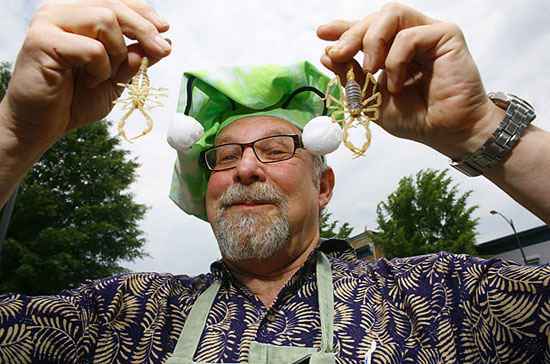
David George Gordon, who won last year's bug cookoff, is an ardent advocate of insect cuisine. Photo/Time
Fancy yourself an adventurous eater? The county’s Natural History Museum has something to challenge your palate at the 26th annual Bug Fair. That’s right—it’s time to grub on grubs.
The “Bug Chef Cook-Off” debuted at last year’s fair, and it’s back again in 2012 by popular demand. Three of the top entomophagists (bug chefs) from across the country are ready to go antenna to antenna with their best bug dishes.
They’re part of a burgeoning bug cuisine movement that’s grabbed the attention of publications including Time and The New Yorker, which have chronicled the efforts of those seeking to make insects palatable as human food for a variety of environmental, ethical and economic reasons.
One of the movement’s stars, David George Gordon, won last year’s cook-off at the museum with tempura-battered tarantula and teriyaki grasshoppers on rice noodles. Gordon, 62, an ardent bug consumption advocate, said hosting the cook-off is a very progressive move by the museum.
“In the United States and Europe it is an uphill struggle,” said Gordon. “Europeans have a bad attitude about bugs. But meat is basically muscle, whether from a tarantula or a cow. Tarantula has a similar texture to crab.”
Gordon, a science writer in the process of updating his Eat a Bug Cookbook, said a trip to Switzerland inspired him to add fondue to this year’s menu (think decadent, chocolate-dipped locusts).
Daniella Martin, the brains behind the Girl Meets Bug blog, is on her own mission to bring critter cuisine to the public. Her YouTube videos offer step-by-step instructions on how to cook and eat things like wax worm tacos and fried scorpion.
The third contestant is David Gracer, 47, of Rhode Island. He is the founder of Small Stock Foods, a company that arranges educational programs, bug tastings, bug catering and bug food sales. He has appeared on “The Colbert Report” and the “Tyra Banks Show” to promote human consumption of bugs. According to Gracer, the reasons to eat insects are both environmental and culinary.
“It’s a good way of dealing with overpopulation by conserving our water and food resources,” said Gracer. “On the other hand, there is also the adventure and fun of eating something new. When you eat insects you are eating closer to nature.”
Gracer’s dishes will feature wax worms, Ugandan katydids (“surprisingly rich, they taste a lot like crispy French fries”) and a surprise ingredient—maybe giant ants, he said.
In addition to competition dishes, the chefs plan on providing courageous attendees with free samples, like Gordon’s famous Chirpy Chex Party Mix. (The “chirpy” part, as you may have guessed, is roasted crickets.)
The Bug Fair, which bills itself as the biggest bug festival in North America, will provide plenty of other entertainment, too—entertainment that doesn’t involve eating or watching other people eat bugs.
The theme for Bug Fair 2012 is the “Year of the Fly,” and if that conjures thoughts of biting horseflies or pesky gnats, museum curator of entomology Dr. Brian Brown wants a chance to change your perspective.
“A few bad apples like mosquitoes that have ruined our thinking about flies,” said Brown. “Most are neutral or beneficial to humans.”
For example, Brown will be presenting “flower flies,” which look a lot like wasps or bees. Brown said flower flies are important pollinators that also feast on aphids— the small, plant-devouring pests that are the bane of gardeners everywhere. Brown also said the flies are a popular subject for amateur naturalists who have moved beyond the most popular species like birds and butterflies.
Other attractions at the event include bug pinning demonstrations, bug-sniffing dogs, specimen handling opportunities and “Supersized Insect Walkabouts”—costumed performances that include a giant monarch butterfly on stilts. The museum and its insect exhibits will also be on display, along with a related special exhibition of jewel-encrusted butterfly brooches in the Gem and Mineral Hall.
The Bug Fair runs from 9:30 a.m. to 5 p.m. on Saturday, May 19, and Sunday, May 20. Tickets are $12 for adults, $9 for seniors and students, $8 for youth ages 13 to 17 and $5 for children ages 5 to 12. Kids under 5 are free. Parking is $8 or $10 in adjacent lots, but attendees may opt to try Metro’s new Expo Line, which has two stops just a short walk from the museum.

Out of the frying pan and into the belly? Maybe, if the eating public decides that bugs are food. Photo/Time
Posted 5/16/12







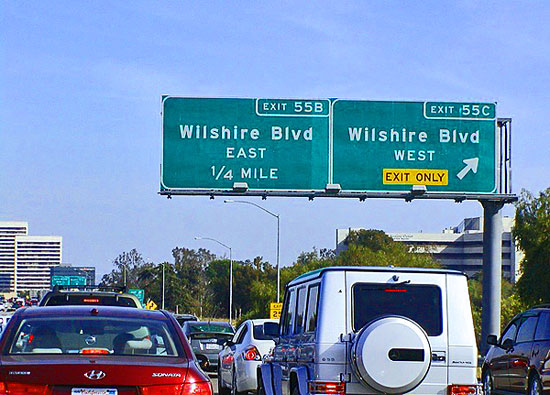
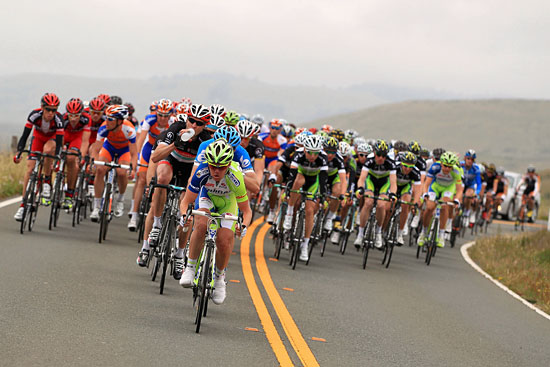

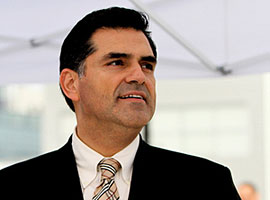
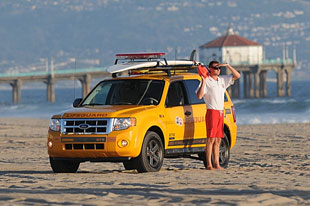















 Check for the latest closure information
Check for the latest closure information








